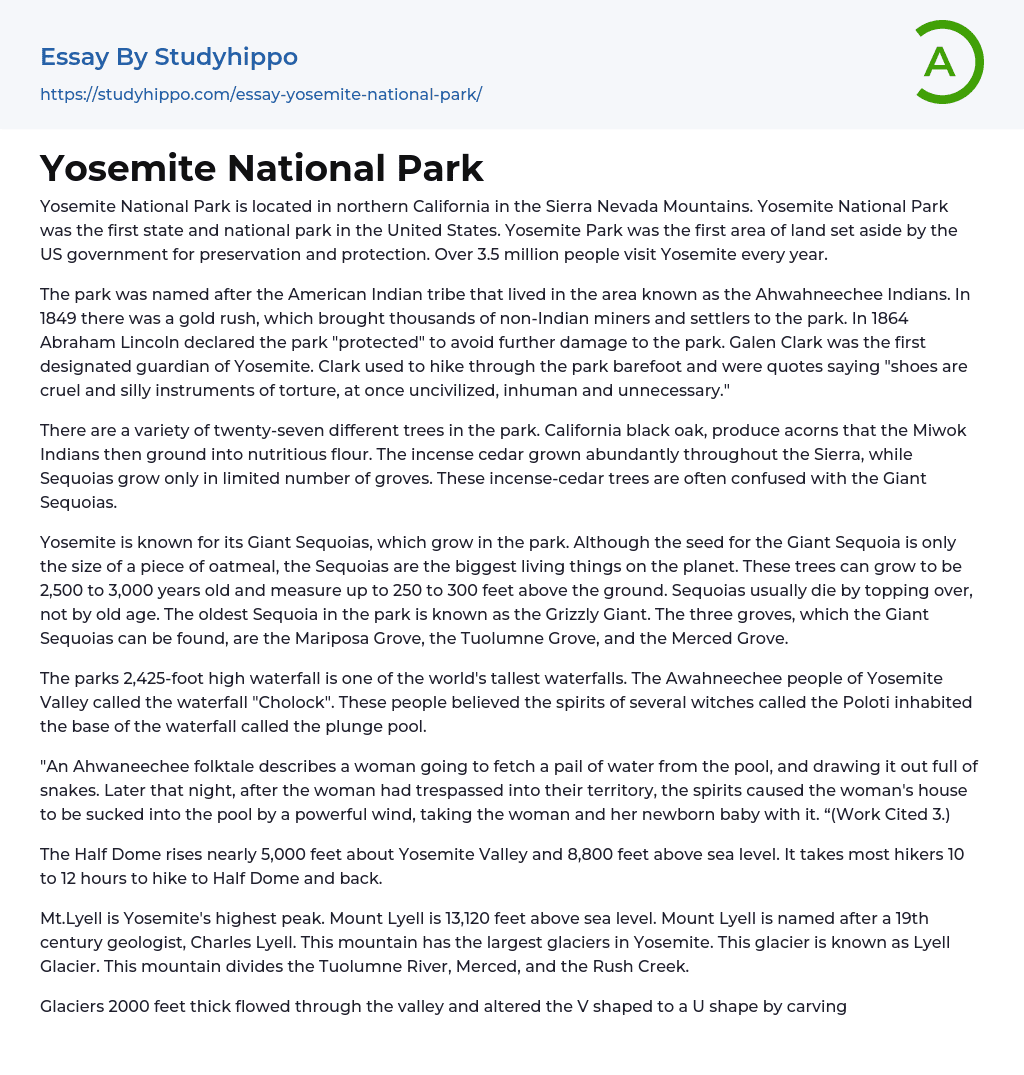Yosemite National Park, located in the Sierra Nevada Mountains of northern California, is both the first state and national park in the United States. It holds historical significance as it was originally designated by the US government for conservation and protection. Today, with over 3.5 million annual visitors, Yosemite Park continues to be a beloved destination.
The park, named after the Ahwahneechee Indians, was inhabited by this American Indian tribe. The gold rush in 1849 attracted many miners and settlers to the area. To protect it from further damage, Abraham Lincoln designated it as a preserved area in 1864. Galen Clark, Yosemite's first appointed guardian, became famous for walking around barefoot in the park. He famously voiced his belief that shoes are a cruel and unnecessary tool that lacks civility and huma
...nity.
The park boasts a variety of trees, encompassing twenty-seven distinct species. Among them is the California black oak, which was utilized by the Miwok Indians to produce flour using its acorns. While numerous incense cedar trees can be found in the Sierra region, only a limited number of Giant Sequoia groves exist. It is frequently observed that individuals mistakenly identify the incense cedar tree as the Giant Sequoia.
The Giant Sequoias in Yosemite National Park are globally renowned as the largest living organisms on Earth. Despite their small seed size, similar to a piece of oatmeal, these trees can live for 2,500 to 3,000 years and grow as tall as 250 to 300 feet. Typically, it is not old age but rather falling over that causes their demise. The park's oldest Giant Sequoia is known as the Grizzly Giant.
You can find these impressive trees in three groves within the park: Mariposa Grove, Tuolumne Grove, and Merced Grove.
The park includes a colossal waterfall, recognized as one of the highest waterfalls globally, with a height of 2,425 feet. The native Awahneechee people named this waterfall "Cholock" and held the belief that it was inhabited by a coven of witches known as the Poloti. According to their beliefs, these witches resided in an area called the plunge pool situated at the bottom of the waterfall.
In an Ahwaneechee folktale, a woman ventured to collect water from a pool. To her astonishment, she discovered that the pail she pulled out was teeming with snakes. That night, the spirits sought retribution for the woman's intrusion into their domain. They conjured a powerful wind that forcefully drew the woman's house into the pool, ultimately engulfing both her and her newborn child within its depths (Work Cited 3).
The Half Dome, which stands at an elevation of approximately 8,800 feet above sea level, rises nearly 5,000 feet over Yosemite Valley. It typically takes hikers around 10 to 12 hours to complete the hike to Half Dome and return.
Mt. Lyell, which reaches an elevation of 13,120 feet above sea level in Yosemite, is notable for hosting the park's largest glaciers called Lyell Glacier. The mountain was named after Charles Lyell, a respected geologist during the 19th century. In addition to its impressive glacial characteristics, Mt. Lyell acts as a natural division between the Tuolumne River, Merced River, and Rush Creek.
Glaciers with a thickness of 2000 feet once flowed through the valley, transforming its V
shape into a U shape by eroding the bottom of the valley. Some rocks now have a shiny, flat surface left by these glaciers. The weight of the glaciers caused sand and small abrasive objects to press against the granite, creating distant striations. The domes surrounding Tenaya Lake bear these glacier markings.
Yosemite National Park spans approximately 1,200 square miles and is home to around 7,000 plant species native to California. Roughly twenty percent of these species can be found within the park. In addition to its rich flora, Yosemite also serves as a habitat for several rare and endangered animals including great gray owls (Strix Nebulosa), coyotes (Canis Latrans), Mule Deer, Squirrels, Steller's Jay, and Peregrine Falcons.




